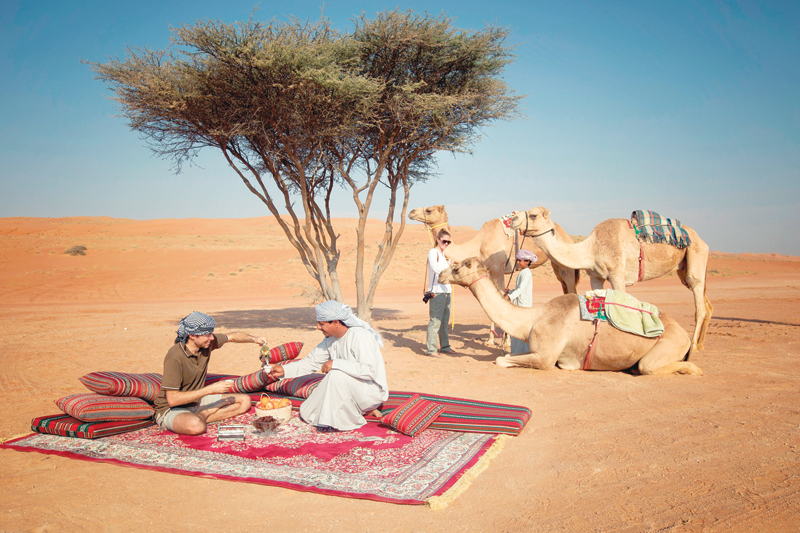

How about manually extracting herbal oil from shua seeds and creating a vial of awesome perfume, even as you allow the exhilaratingly soothing exotic environment to soak in? Or spinning and weaving with your hands, or baking a traditional Omani bread? Or grinding coffee beans using an antique pestle and mortar and getting lost in the intense fragrance, or moulding exquisite pottery on the potter’s wheel, with the fired up clay kilns forming an awesome backdrop?
Travel can be a highly creative quest.
Creative tourism, arguably the most appealing version of tourism, doesn’t subscribe to the long held view of traveller as a passive soul destined to merely observe the seemingly contradictory, deeply subtle or even meaningless images and ways of lives, and keep walking.
It demands the tourist’s total involvement; a commitment to the present; and eventually the realisation that travel is just an excuse for one’s self to merge with the destination.
This economically significant new-generation tourism option is unique in that it involves both the tourists and the locals in the creation of diverse tourist products. This co-creation aspect adds great value to the local economy of the destination.
Though the concept emerged in the 2000s as a form of tourism that offers visitors the exciting opportunity to showcase or develop their creative potential through active participation in courses and learning experiences that are characteristic of the holiday destination, its real power and beauty took some time to be appreciated in a significant way at the global level. We owe a great deal to Crispin Raymond and Greg Richards for establishing the philosophical framework for creative tourism.
The shift from cultural tourism to creative tourism is significant. It denotes a paradigm change in perception and sensitivity with respect to tourism. While cultural tourism has had a great run over the last few decades, with an increasing number of tourists showing interest to learn about different cultures and histories, its growth created its own set of issues such as commodification of indigenous cultures and environmental impact. Also we witnessed what is referred to as a “cultural arms race” across the world, with countries vying to grab the maximum tourists by developing as many cultural attractions as possible. Finally, the supply of cultural hotspots outstripped demand.
As noted by Rasky, the Mcdonaldisation of passive cultural consumption meant it is increasingly difficult for countries to develop a distinctive cultural identity; and this led to the focus shifting to creative tourism, and cultural consumption giving way to cultural creation.
The informed tourist wants to discover a destination through real time experience, and looks forward to being part of the destination’s culture and daily life.
It’s entirely up to the local governments and destination management companies to offer the best mix of creative experiences to the visitors. The key point is that diversification of tourist offers is possible without any investment, just by optimizing the available heritage framework. Existing cultural infrastructures tend to benefit greatly from the new found demand.
Creative tourism also engenders cultural renaissance in the destination, and creates jobs for the locals including artisans. Above all, it’s a year-round tourist activity, and empowers “geographical outsourcing”, which means better spatial distribution within the destination.
As creative tourism enriches natural and cultural resources without degrading to exploitation, it’s possibly the most appreciated tourist project.
As against conventional tourists, creative tourists are more skilled in TICs, languages and humanities, and belong to a wide array of social communities. They value better interaction and want to produce value-added contents and experiences.
Tour operators can offer great packages by strategically combining creative tourism with eco, adventure, spiritual and culinary tourism options.
For the destination to be a creative tourist attraction, it must have the resources to offer tourists platforms where they can experience local culture by participating in artistic and creative activities without feeling as an outsider.
Referred to as “the jewel in the Arabian crown”, the Sultanate is a treasure island of authentic Arabian culture and heritage and amazing geography, traditionally renowned for its appreciation of diversity, social harmony and progressive vision: A terrific combination that can position itself as the foremost creative tourism destination.
Creative tourism can resuscitate dying traditional creative industries in Oman, such as the (Bahla) pottery and weaving of mats (Haseer) and carpets, to name a few; instil a sense of pride among communities; and rejuvenate local economy.
Only a few dots need to be connected.
Oman Observer is now on the WhatsApp channel. Click here



